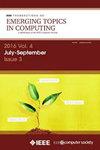CAT SNN: Conversion Aware Training for High Accuracy and Hardware Friendly Spiking Neural Networks
IF 5.4
2区 计算机科学
Q1 COMPUTER SCIENCE, INFORMATION SYSTEMS
IEEE Transactions on Emerging Topics in Computing
Pub Date : 2024-08-02
DOI:10.1109/TETC.2024.3435135
引用次数: 0
Abstract
Among the various training algorithms for spiking neural network (SNN), ANN-to-SNN conversion gained popularity due to high accuracy and scalability to deep networks. By converting artificial neural network (ANN) to SNN and employing conversion loss reduction techniques, previous ANN-to-SNN conversion approaches achieved good accuracies. However, previous works do not consider the overheads to implement conversion loss reductions in hardware, thereby limiting its feasibility of hardware implementation. In this paper, we present conversion aware training (CAT), where SNN is simulated as closely as possible during ANN training for obtaining SNN-like ANN. So, our approach does not need any conversion loss reduction techniques after conversion, thus reducing hardware overhead while achieving state-of-the-art accuracies for SNNs using various neural coding methods. In addition, as an application of CAT for obtaining a hardware friendly SNN, we demonstrate a lightweight time-to-first-spike (TTFS) coding that adopts logarithmic computations enabled by CAT. An SNN processor that supports the logarithmic TTFS is implemented in 28nm CMOS process, achieving 91.7/67.9/57.4% accuracy and 486.7/503.6/1426uJ inference energy on CIFAR-10/100/Tiny-ImageNet, when running 5-bit logarithmic weight VGG-16. The key contributions are 1) proposing CAT as an ANN-to-SNN conversion guideline 2) applying CAT on various neural codings 3) presenting co-designed TTFS coding and processor.CAT SNN:针对高精度和硬件友好型尖峰神经网络的转换感知训练
在尖峰神经网络(SNN)的各种训练算法中,ann -SNN转换因其精度高、可扩展到深度网络而受到广泛欢迎。通过将人工神经网络(ANN)转换为SNN并采用转换损失降低技术,以往的ANN- SNN转换方法取得了较好的精度。然而,以往的工作没有考虑在硬件上实现降低转换损耗的开销,从而限制了其硬件实现的可行性。在本文中,我们提出了转换感知训练(CAT),在神经网络训练过程中尽可能地模拟SNN,以获得类SNN神经网络。因此,我们的方法在转换后不需要任何转换损耗降低技术,从而减少硬件开销,同时使用各种神经编码方法实现最先进的snn精度。此外,作为CAT获得硬件友好SNN的一个应用,我们演示了一种轻量级的TTFS编码,该编码采用了CAT支持的对数计算。采用28nm CMOS工艺实现了支持对数TTFS的SNN处理器,在CIFAR-10/100/Tiny-ImageNet上运行5位对数权值vug -16时,实现了91.7/67.9/57.4%的精度和486.7/503.6/1426uJ的推理能量。主要贡献有:1)提出CAT作为ann到snn转换指南;2)将CAT应用于各种神经编码;3)提出共同设计的TTFS编码和处理器。
本文章由计算机程序翻译,如有差异,请以英文原文为准。
求助全文
约1分钟内获得全文
求助全文
来源期刊

IEEE Transactions on Emerging Topics in Computing
Computer Science-Computer Science (miscellaneous)
CiteScore
12.10
自引率
5.10%
发文量
113
期刊介绍:
IEEE Transactions on Emerging Topics in Computing publishes papers on emerging aspects of computer science, computing technology, and computing applications not currently covered by other IEEE Computer Society Transactions. Some examples of emerging topics in computing include: IT for Green, Synthetic and organic computing structures and systems, Advanced analytics, Social/occupational computing, Location-based/client computer systems, Morphic computer design, Electronic game systems, & Health-care IT.
 求助内容:
求助内容: 应助结果提醒方式:
应助结果提醒方式:


